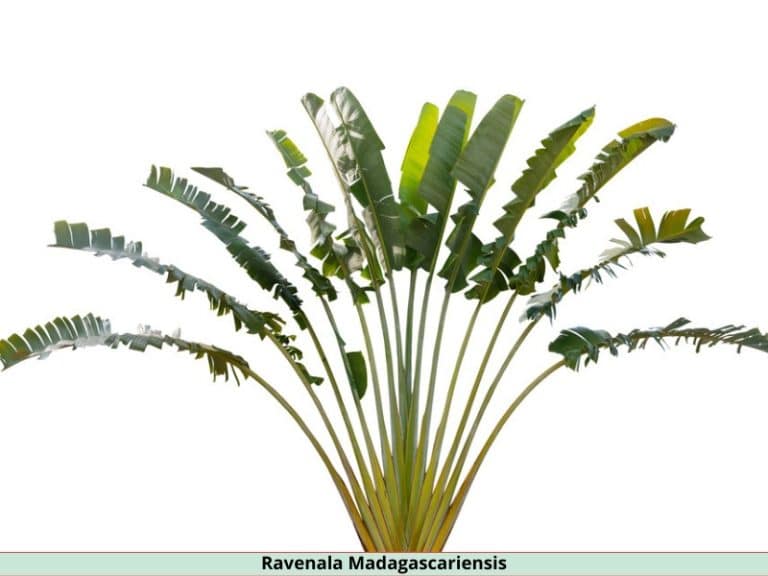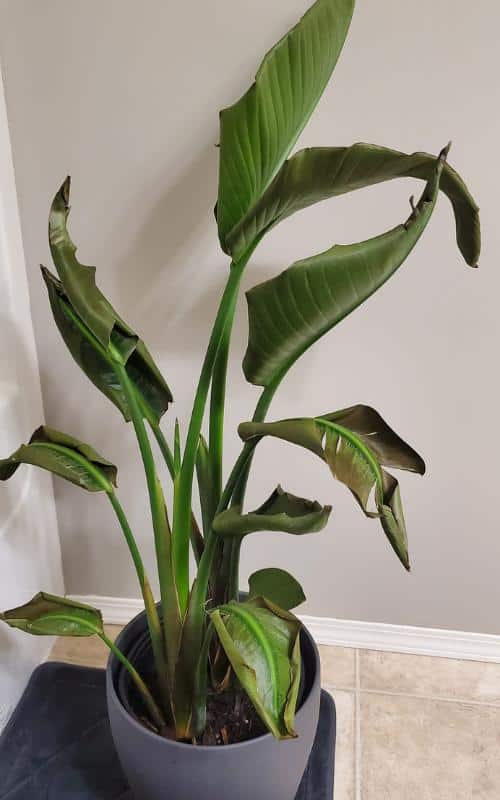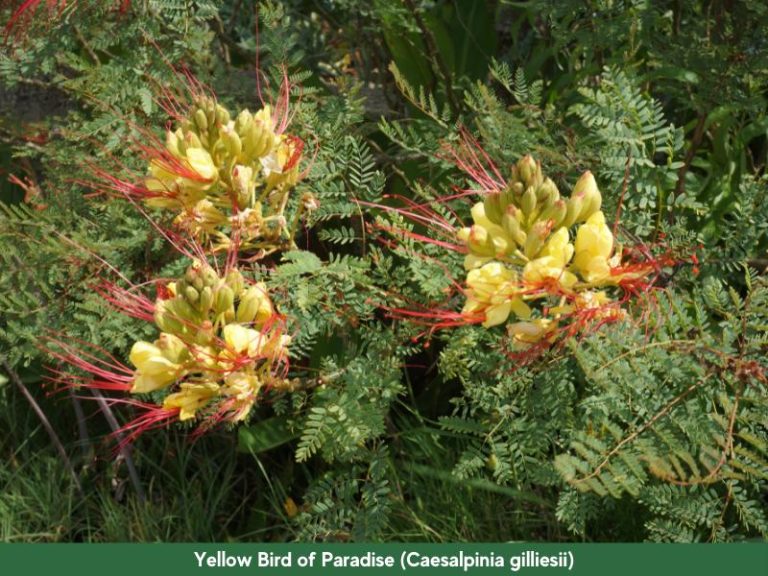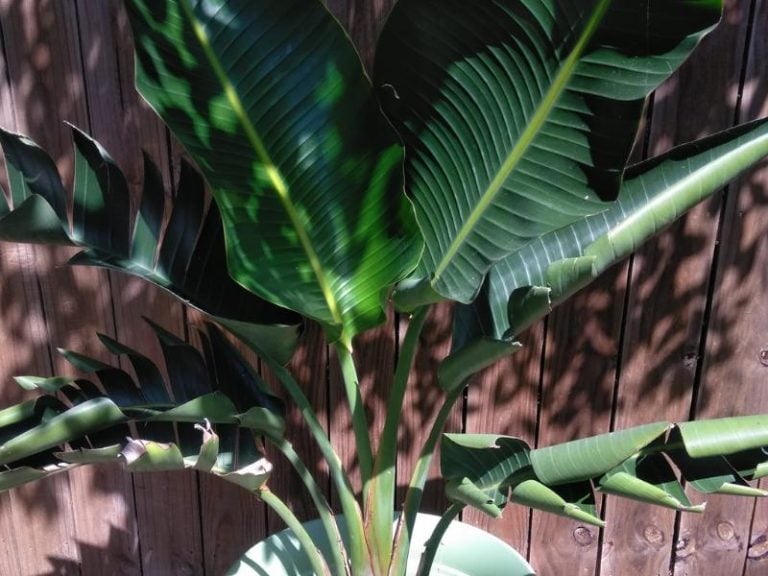Bird of Paradise Problems + How to Fix Them
The exotic bird of a paradise plant blooms beautifully. It is known for its lush foliage and is used as a house attraction. Your bird of paradise plant can be affected by problems that change its appearance and health. But, you will see positive changes that restore your plant’s rich color and health if you take the appropriate steps.
Common problems with the bird of paradise plant include leaflessness, root rot, curling and yellowing leaves, brown edges, leaf splitting, top heaviness, legginess, and failure to bloom. You can fix these problems with proper care that includes feeding the plant adequately, providing bright direct light, and watering once every 1-2 weeks.
I’ve explained how you can identify each of these issues below and provided the best solutions to help you grow healthy strelitzia plants indoors and outdoors.
Is it easy to care for a bird of paradise plant?
Bird of paradise is an easy plant to care for if the conditions are right.
As a tropical plant, bird of paradise can adapt to various conditions. It can withstand changes in weather patterns and maintenance habits. As such, it is regarded as a low-maintenance plant.
Here are the growing needs of the strelitzia plant:
- Adequate water every one to two weeks
- Fertile soil that drains properly
- About 65°F-85°F temperature outdoor and 65° to 70°F indoors.
- At least 50% humidity and sufficient direct or indirect light.
- Pruning and trimming using sharp tools only if necessary
- Fertilizer in summer or spring.
Keep in mind that if you do not provide proper care for the bird of paradise plant, it is bound to develop some or multiple problems discussed below:
Common bird of paradise problems
It might be challenging to provide a tropical-like environment for the bird of paradise to thrive. The growing conditions in a home cause problems for the plant, preventing it from reaching its full potential.
Here are common problems with the bird of paradise plant and how to fix them:
| Problem | Main sign(s) | Best fix |
| Leaflessness | Leaf shedding and dying. | Provide sufficient water, fertilizer and supplements. |
| Root rot | Rotten roots; black or brown roots. | Cut the rotten roots; stop overwatering. |
| Curling leaves | Leaves curling upward or inward. | Water the plant regularly; maintain a nutrient-rich slightly acidic soil. |
| Yellowing leaves | Leaves turning yellow suddenly or gradually. | Water once every 1-2 weeks; fix nutrient deficiencies with organic fertilizer, commercial fertilizer, or supplements. |
| Brown edges/tips | Brown edges or tipsCrispy discolored edges | Water once every 1-2 weeks; increase humidity to at least 50%. |
| Leaf splitting | Splitting of leaves along the veinsTears on the leaves | Move the plant to a different location with less wind, more humidity. |
| Top heaviness | Lopsided plant | Rotate the plant toward the light; prune with loppers or pruning saws. |
| Legginess/growing too tall | Weak, tall stems | Feed the plant and provide proper lighting. |
| Failure to bloom | Failure to produce budsFailure to flower | Provide adequate water and light; reduce nitrogen |
1. Leaflessness
Bird of paradise has attractive leaves that do not normally fall off. However, the leaves can sometimes droop and collapse due to several reasons.
Leaf shedding causes leaflessness. Leaf shedding is a sign of stunted growth in the bird of paradise plant.
Water is an important component in the production of flowers and leaves. Lack of water or too much water causes bird of paradise shed leaves. You’ll need to supplement water to sustain your plant during long droughts.
Other causes of leaflessness include:
- Old leaves
- Shock from transplanting
- Pests and diseases
- Low humidity
- Light deprivation
Fixing leaflessness requires you to stick to the correct maintenance methods.
Provide adequate water with proper drainage to prevent overwatering and underwatering. You should also ensure that the plant has all the necessary nutrients and light.
2. Root rot
Overwatering is the main culprit behind root rot in bird of paradise plants. Soggy soil limits the roots’ oxygen absorption. Root rot weakens the roots and limits water intake and nutrient absorption. It exposes the plant to fungi and bacterial attacks, curled leaves, wilting and probable death.
Rotten roots are mushy and brown or black. Cut the rotten roots with sharp pruning shears. You should also check the potting mix and replace it if you need to. Use a free-draining potting mix. You can add gravel or stone to improve drainage and aeration.
Home remedies like chamomile, cinnamon, and charcoal are helpful in treating root rot.
3. Curling leaves
Curling strelitzia leaves is a sign of moisture loss. The leaves curl inwards to minimize the surface area the leaf uses to lose water. Underwatering, low humidity, heat stress, and cold drafts are the causes of leaf curling. Additionally, transplanting and pest and diseases could also cause curling leaves.
Curling may result in the leaves withering and even wilting.
Ensure you water frequently to cater for the water lost by transpiration. Fix low humidity by misting the plant or using a humidifier to prevent drooping and the death of leaves of bird of paradise.
4. Yellowing leaves
Yellowing leaves are a sign of low humidity or that your plant is underwatered. The leaves can turn yellow due to a lack of nutrients. These nutrients include magnesium, iron, zinc, and nitrogen.
Inadequate sunlight is another reason for the yellowing of the leaves. Bird of paradise requires direct sunlight for at least 6 hours.
Organic fertilizers such as blood meal, manure and sludge will give the soil the nutrient boost it need to promote health growth for your bird of paradise plant. Still, you can supplement it with inorganic NPK 1:1:1 fertilizer. Use Iron supplements to correct iron deficiency.
Water the plant correctly to ensure the fertilizer seeps into the soil. Move the plant to a spot where it can get adequate sunlight.
5. Brown edges/tips
Browning of leaves is a common occurrence indicative of many problems. Brown edges are caused by water that has chlorine or other salts. In some areas, chlorinated or fluoride-treated tap water is a culprit that’s causing brown edges in bird of paradise plants.
Underwatering, low humidity, fungal infection, and lack of light are other reasons for brown tips.
The leaves become brown along the edges before becoming crunchy.
Because of the sensitivity of the bird of paradise plant, substitute tap water with pure, filtered water. Also, rectify the humidity by misting the plant regularly or using a humidifier.
6. Leaf splitting
Leaf splitting is a normal occurrence in bird of paradise plants. The leaves split along the veins or unravel.
Bird of a Paradise leaves can split due to strong winds, low humidity, watering issues or infections. Human and animal activity can also cause tears on the leaves.
Although you can expect it, you can prevent and correct bird of paradise leaf splitting.
To rectify the splitting problem, remove the split leaves. Also, consider moving the plant away from direct sunlight or wind.
7. Top heaviness
Bird of paradise grows tall and can have many stems. It appears top-heavy when the plant grows to the maximum height — about 60-72 inches — and has grown leaves. It can become lopsided as the stems struggle to support the weight.
Bird of a paradise can lean due to root rot, lack of pruning, and uneven exposure to light.
Rotate the plant to correct the leaning caused by the uneven distribution of light. You should prune your plant with sharp shears, loppers, or pruning saws. Prune the old leaves and stems at the beginning of spring.
8. Legginess/growing too tall
The bird of paradise plant is one of the fastest-growing indoor plants. It can reach 5-6 feet tall and 3-5 feet wide in its growing period. It takes around five years to mature to its maximum height.
It can, however, become leggy if its stems are weak and thin. Legginess occurs when the foliage develops faster, and the stems and roots cannot support the plant.
Bird of paradise becomes too tall due to improper lighting and high nitrogen soils.
To rectify legginess, reduce nitrogen fertilizer and increase potassium that promotes root development and plant health. You should also provide proper moisture, lighting, nutrition, and drainage.
9. Failure to bloom
The bird of paradise plant takes a long time to bloom, especially if you plant it young. It takes about five years for a young plant to flower.
Bird of paradise might fail to bloom because of insufficient light and incorrect repotting.
Buy more mature plants if you want a speedy bloom. However, mature bird of paradise plants cost more than young ones.
The remedies may take several tries before it has an effect because the bird of paradise is a slow-growing plant. After applying the methods recommended, the plant will restore itself.
Routine maintenance procedures are essential to preventing and treating bird of paradise problems. For your bird of a paradise plant to look vibrant, clean the leaves, deal with pests and diseases and prune to promote growth.






